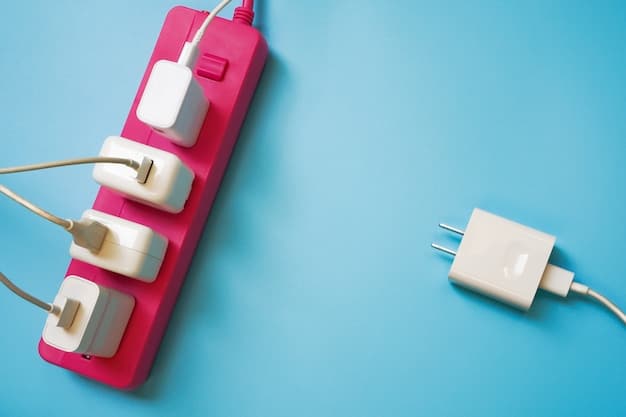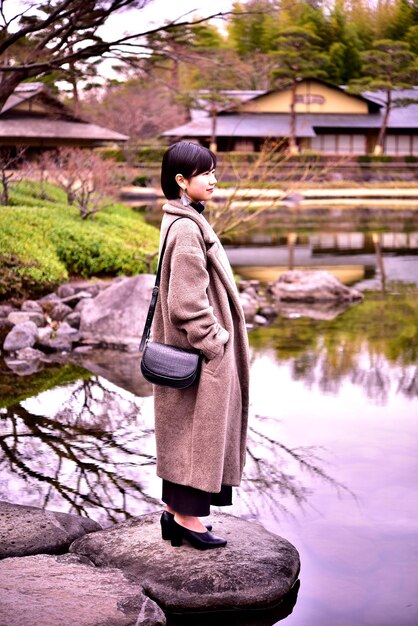The Ultimate Japan Packing List for US Tourists: Pack Smart!

Preparing for a trip to Japan? This ultimate packing list for US tourists covers everything you need to bring, from essential travel documents and electronics to clothing and medications, ensuring a smooth and enjoyable experience while leaving unnecessary items behind.
Planning a trip to Japan from the US can be exciting, but packing efficiently is key. This ultimate Japan packing list for US tourists: what to bring and what to leave behind guide will help you prepare for your adventure, ensuring you have everything you need while avoiding unnecessary baggage.
Essential Travel Documents for Japan
Before anything else, ensure you have your necessary travel documents. These are non-negotiable for entry into Japan and should be kept secure but easily accessible.
Passport and Visa Requirements
US citizens can enter Japan for tourism purposes for up to 90 days without a visa. However, your passport must be valid for the entire duration of your stay. It’s wise to have at least six months of validity remaining to avoid any issues. Always carry a physical copy of your passport, separate from your original, in case of loss or theft.
Flight and Accommodation Confirmations
Keep printed or digital copies of your flight tickets, hotel reservations, and any tour bookings. These confirmations can be useful for immigration and hotel check-ins. Consider saving these documents on your phone and cloud storage for easy access. Also, ensure that someone back home has copies of these documents in case of an emergency.
- Passport with at least six months validity
- Flight and accommodation confirmations (printed and digital)
- Travel insurance details
- Copies of essential documents stored separately
Having these essential travel documents in order will set the stage for a stress-free journey. Ensure you double-check their validity and accessibility before you depart.
Electronics and Gadgets for Japan
Japan is a technologically advanced country, but ensuring your electronics are compatible and prepared is still crucial. This section covers the essential gadgets and accessories you should pack.

Universal Travel Adapter
Japan uses Type A and Type B outlets, which are different from the US. Bring a universal travel adapter to charge your devices. Consider buying one with multiple USB ports to charge several devices simultaneously.
Portable Charger
A portable charger (power bank) is invaluable for long days of sightseeing. Ensure it is fully charged before you leave your hotel and keep it in your daypack. This will help you avoid the frustration of a dead phone battery while navigating or taking photos.
Camera and Accessories
If you enjoy photography, bring a good camera to capture the stunning landscapes and vibrant cityscapes. Don’t forget extra batteries and memory cards, as you’ll likely take more photos than you anticipate. A small tripod can also be useful for taking stable shots and group photos.
- Universal travel adapter with USB ports
- Portable charger
- Camera with extra batteries and memory cards
- Smartphone
Being prepared with the right electronics ensures you can stay connected, capture memories, and navigate Japan without any technological hiccups. Always check the voltage compatibility of your devices to prevent damage.
Clothing Essentials for Your Japan Trip
Packing the right clothing is crucial for comfort and adaptability to Japan’s diverse climate and cultural norms. Choose versatile pieces that can be layered and easily mixed and matched.
Versatile Clothing Choices
Pack lightweight, breathable clothing that can be layered. Consider the season you are traveling in. Spring and fall require layers, while summer can be hot and humid. A light jacket or sweater is useful even in summer for air-conditioned spaces. Comfortable walking shoes are a must, as you’ll be doing a lot of walking.

Appropriate Attire for Temples and Shrines
When visiting temples and shrines, dress respectfully. Avoid wearing overly revealing clothing. It’s a good idea to have a light scarf or shawl to cover your shoulders if needed. Some temples may require you to remove your shoes, so easy-to-remove shoes are a plus. Also, socks without holes are essential!
- Lightweight, breathable clothing for layering
- Comfortable walking shoes
- Light jacket or sweater
- Respectful attire (scarf or shawl)
Packing versatile and respectful clothing will ensure you are comfortable and appropriately dressed for any situation you encounter in Japan. Always check the local weather forecast before your trip to make any necessary adjustments to your packing list.
Health and Personal Care Items
While Japan has excellent pharmacies, it’s wise to bring essential health and personal care items from home. This ensures you have familiar products and can address minor health issues immediately.
Medications and First Aid
Pack any prescription medications you require, along with a copy of your prescription. Bring basic over-the-counter medications for common ailments like headaches, stomach upset, and allergies. A small first-aid kit with bandages, antiseptic wipes, and pain relievers is also a good idea. Remember to check regulations regarding medication permitted into Japan.
Personal Hygiene Products
Bring travel-sized versions of your favorite personal hygiene products, such as shampoo, conditioner, soap, and toothpaste. While these are available in Japan, familiar brands can provide comfort. Consider a travel-sized hand sanitizer, as public restrooms may not always have soap.
- Prescription medications with a copy of the prescription
- Over-the-counter medications
- First-aid kit
- Travel-sized personal hygiene products
Having these health and personal care items readily available will provide peace of mind and ensure you can take care of yourself while traveling. Always check the expiration dates of medications before packing.
Money and Payment Methods in Japan
Understanding payment methods is essential for a smooth trip. While credit cards are becoming more widely accepted, cash is still king in many smaller establishments.
Cash vs. Credit Cards
While major credit cards like Visa and Mastercard are accepted in larger stores, hotels, and restaurants, many smaller businesses, especially in rural areas, operate on a cash-only basis. It’s a good idea to carry a mix of cash and credit cards. Notify your bank of your travel plans to avoid any blocked transactions.
Withdrawing Cash in Japan
ATMs that accept foreign cards can be found at major airports, post offices, and 7-Eleven convenience stores. Check with your bank about international transaction fees before you leave. Consider withdrawing cash upon arrival at the airport to have some local currency on hand. Also, be aware of daily withdrawal limits.
- Mix of cash (Japanese Yen) and credit cards
- Notification to your bank about travel plans
- Knowledge of ATM locations that accept foreign cards
- Small coin purse
Being prepared with various payment methods will ensure you can make purchases without any issues. A small coin purse is useful, as Japan uses coins frequently.
Other Useful Items to Pack
Beyond the essentials, several other items can enhance your travel experience in Japan. These include items for comfort, convenience, and cultural immersion.
Phrasebook or Translation App
While many Japanese people in tourist areas speak some English, having a phrasebook or translation app on your phone can be invaluable, especially when venturing off the beaten path. Apps like Google Translate can help you communicate in real-time. A phrasebook can also be useful for learning basic Japanese phrases, showing respect for the local culture.
Reusable Water Bottle
Staying hydrated is essential, especially during warmer months. Bring a reusable water bottle and refill it at public water fountains or your hotel. This is also an environmentally friendly option. Carrying a small, foldable water bottle is a great space-saving alternative.
- Phrasebook or translation app
- Reusable water bottle
- Small backpack or daypack
- Comfortable face mask
These additional items can significantly improve your comfort and convenience while traveling in Japan. A small backpack is useful for carrying your essentials during day trips, and comfortable shoes are a must for all the walking you’ll be doing.
Items to Leave Behind
Knowing what not to pack is just as important as knowing what to bring. Leaving unnecessary items behind can save you space, weight, and potential hassle.
Excessive Clothing
Avoid overpacking clothing. Japan has excellent laundry facilities, so you can easily wash clothes during your trip. Focus on versatile items that can be mixed and matched. Resist the urge to pack “just in case” items you are unlikely to wear.
Bulky Toiletries
Leave bulky toiletries at home. Travel-sized versions are readily available, and many hotels provide basic toiletries like shampoo, conditioner, and soap. This will also help you comply with airline liquid restrictions.
- Excessive clothing
- Bulky toiletries
- Expensive jewelry
- Unnecessary electronics
By carefully considering what not to bring, you can streamline your packing and travel more comfortably. Remember, less is often more when it comes to travel.
| Key Item | Brief Description |
|---|---|
| 🛂 Passport | Essential travel document, valid for your stay. |
| 🔌 Adapter | Needed to charge US electronics in Japan. |
| 💴 Cash | Essential for smaller establishments. |
| 💊 Meds | Bring prescriptions and basic over-the-counter meds. |
Frequently Asked Questions
▼
Japan uses Type A and Type B outlets, so a universal travel adapter is necessary. Ensure it has multiple USB ports for charging various devices simultaneously.
▼
Yes, cash is still prevalent, especially in smaller establishments and rural areas. It’s wise to carry a mix of cash and credit cards to avoid any payment issues.
▼
Dress respectfully when visiting temples and shrines. Avoid wearing overly revealing clothing, and consider bringing a light scarf or shawl to cover your shoulders if needed.
▼
Yes, tap water in Japan is generally safe to drink. However, if you prefer, you can also easily purchase bottled water from convenience stores and vending machines.
▼
While many people in tourist areas speak some English, learning basic Japanese phrases or using a translation app can be incredibly helpful and enhance your overall experience.
Conclusion
By following this comprehensive packing list, US tourists can ensure they are well-prepared for their trip to Japan. From essential travel documents and electronics to appropriate clothing and payment methods, packing smart can significantly enhance your travel experience, making it more enjoyable and stress-free.





